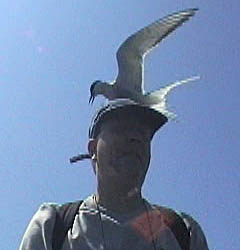To start with the birds, the easy thing to say is there aren't any. Or at least those there are have been hiding from or lazing in the sun like the rest of us - didn't think I'd mention the sun in 2 successive posts this year!

So it was time to look for smaller things again.
The white-lipped snails were ............................ being snails

Also at the wetlands the common blue damsels were common and at it all over the place .........



but the black-tailed skimmer was a first for me - even if it wouldn't settle - hence the rubbish shot

The cinnabar moth caterpillars looked great in the bright light


The peacock was strutting it's stuff

and this wasp was browsing on a wild parsnip (I think). You can't really see in this shot, but this was a wasp with a long thin waist, called Mellinus arvensis - looked better in the flesh!

It preys on hover flies so this Eristalis horticola would be on the lookout ...


A crab spider was also on the hunt.
 Back at home the Eurydema bug was around again, but unfortunately you can't really see the bulging red eyes at this resolution - try clicking on the picture for a bigger view.
Back at home the Eurydema bug was around again, but unfortunately you can't really see the bulging red eyes at this resolution - try clicking on the picture for a bigger view. In the greenhouse a greenbottle contrasted nicely with an astilbe
In the greenhouse a greenbottle contrasted nicely with an astilbe but my foray into entomolgy this month was about the bees which were everywhere in the garden. Again apologies if I get some wrong - just let me know:
but my foray into entomolgy this month was about the bees which were everywhere in the garden. Again apologies if I get some wrong - just let me know:
Bombus terrestris Bombus pratorum (?)
Bombus pratorum (?)
Honey bees (on the best Helenium going - Sahin's Early Flowerer - if you like Heleniums get one!)

Red-shanked bumblebee - at first I thought it was a red tailed, never having heard of a red-shanked, but check out the red hairs on the back legs.
Then there were several types of carder bee (or maybe just 3 forms of 1. There are so many bees, complicated by the fact there are males, females and workers which all look different even within the one species). One shot (it's obvious which) reminds of the drawing in a Winnie the Pooh book where Pooh gets stuck in the honey jar. I'm not sure the last of these is a carder bee, but it might be - bit more research required.


 And finally the bee that became my favourite. It's a male wool carder bee - easily recognised by the gold spots on the abdomen, and also it's yellow wasp like face.
And finally the bee that became my favourite. It's a male wool carder bee - easily recognised by the gold spots on the abdomen, and also it's yellow wasp like face.
 My book says the male is significantly bigger than the female (the female combs hairy plants for nest material - hence the name) and is territorial. It was. It kept going back to the same leaf shown in the top picture, resting for a minute or so and then off on a little patrol of it's patch. If it found another bee it bounced it - literally bouncing on it's back and chasing it off. I thought it was great!
My book says the male is significantly bigger than the female (the female combs hairy plants for nest material - hence the name) and is territorial. It was. It kept going back to the same leaf shown in the top picture, resting for a minute or so and then off on a little patrol of it's patch. If it found another bee it bounced it - literally bouncing on it's back and chasing it off. I thought it was great!












No comments:
Post a Comment